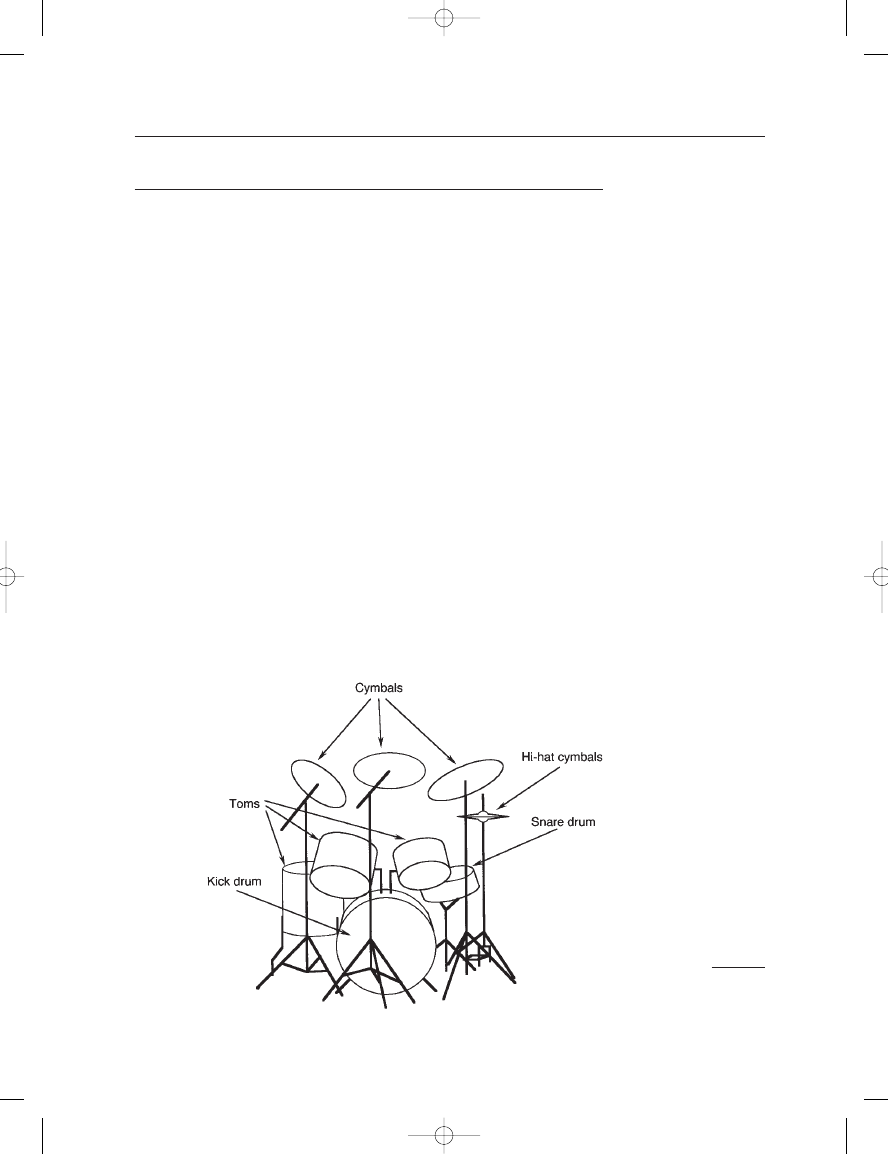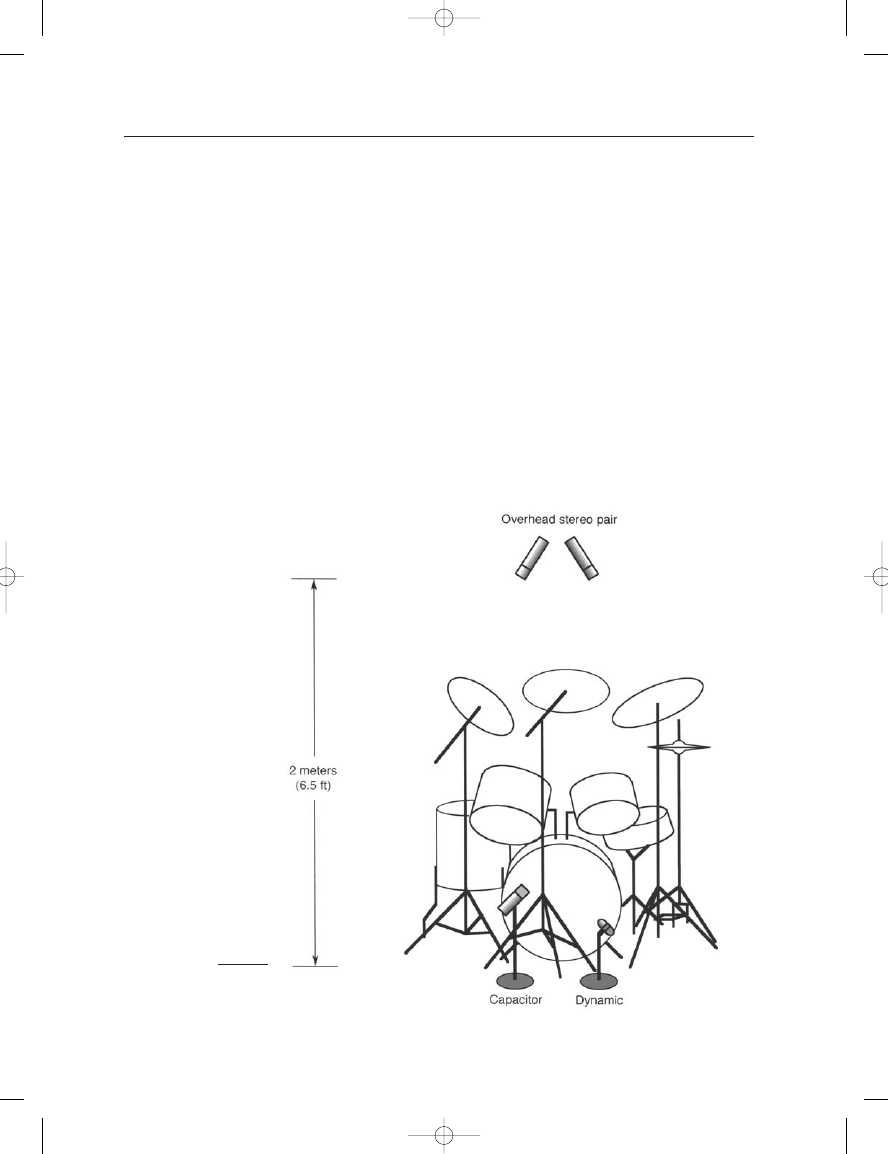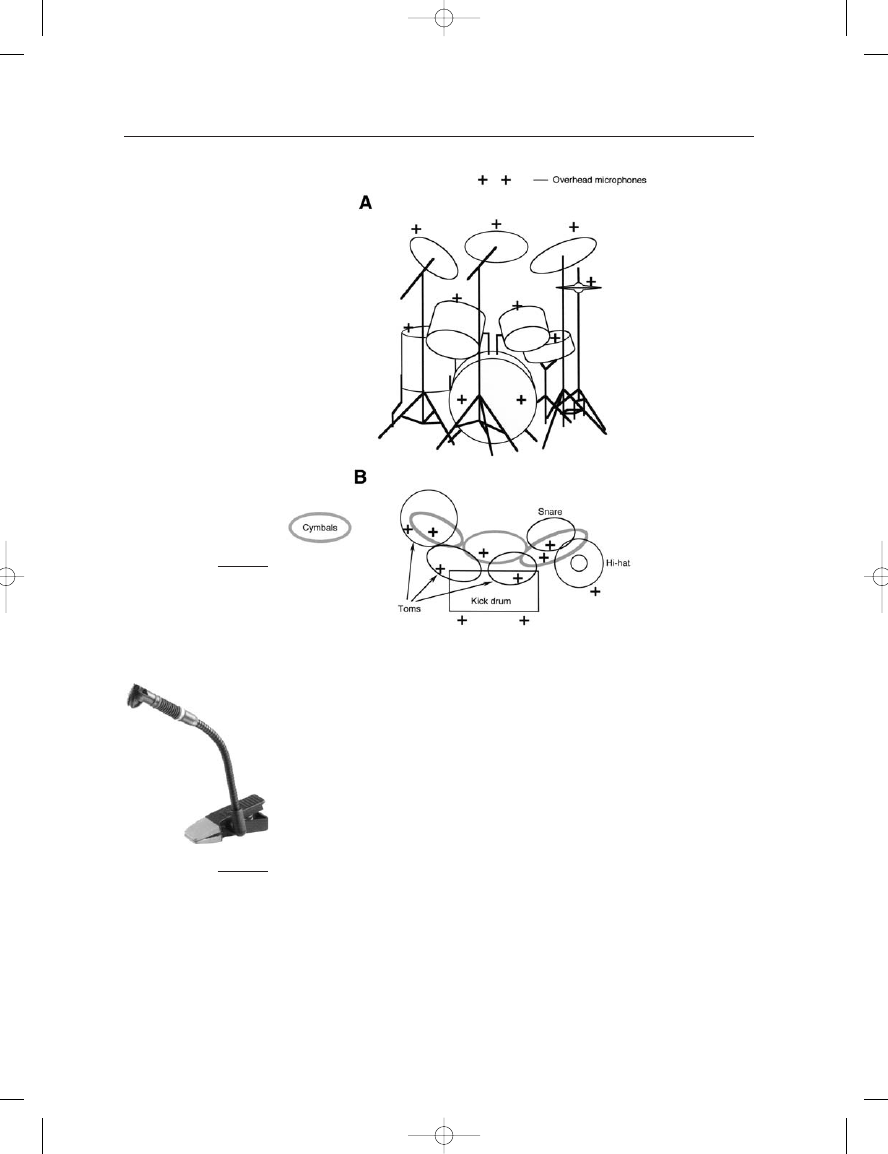ВУЗ: Казахская Национальная Академия Искусств им. Т. Жургенова
Категория: Книга
Дисциплина: Не указана
Добавлен: 03.02.2019
Просмотров: 17297
Скачиваний: 51

RECORDING THE DRUM SET
The drum set is a vital element in virtually all popular and rock music
groups. While its actual makeup may vary from one player to another,
the layout shown in Figure 14–1 is typical. Its basic elements are:
1. Kick drum: played with a spring-loaded beating attachment oper-
ated by the right foot, striking the head of the drum (the head is the
stretched playing surface).
2. Snare drum: played by sticks or light metal brushes with both hands.
The snares (tight gut strings across the rear head) are normally
engaged and give the struck instrument its characteristic “snap”.
3. Hi-hat cymbals: consists of one fixed cymbal and a movable one
which is articulated by the player’s left foot. The pair of cymbals
are struck with a single stick in the right hand, and the left hand is
used to position them, varying the timbre.
4. Overhead cymbals: there are usually three of these, freely struck by
single sticks. The cymbals are often known by the following names:
“ride” cymbal, “crash” cymbal, and “sizzle” cymbal. The last-
named one has multiple small pins located loosely in holes around
the periphery of the cymbal. These vibrate freely, metal-against-
metal when the cymbal is struck, producing a sound rich in high
overtones.
5. Tom-toms: Commonly known as “toms”, these are small drums
struck with sticks.
THE MICROPHONE BOOK
218
FIGURE 14–1
Front view of the modern
drum set.
Earg_14.qxd 14/9/04 2:54 PM Page 218

Anyone who has ever witnessed a studio recording will recall the
drummer’s long setup time and the many adjustments made to the drum
set before playing gets under way. Spurious resonances and ringing must
be damped out, and the player will make absolutely sure that the various
moving mechanisms are silent in their operation.
Every instrument in the drum set will be precisely positioned, and
the microphones, no matter how closely you position them, must not
interfere with the player’s movements in any way.
A SIMPLE RECORDING APPROACH
Many small acoustical jazz groups require only basic pickup of the drum
set, consisting of an overhead stereo pair and a single kick drum micro-
phone. The overhead pair will normally be cardioid capacitors with flat,
extended response. Place these microphones as shown in Figure 14–2,
with their axes aimed at the hi-hat cymbals and right tom, respectively.
Both microphones should be placed slightly higher than the player’s head
14: Studio Recording Techniques
219
FIGURE 14–2
Simple pickup of the
drum set.
Earg_14.qxd 14/9/04 2:54 PM Page 219

and slightly to the rear so that they will not distract the player. The general
aim here is to pick up the sound of the drum set very much as it is heard
by the player. Some engineers prefer to use a near-coincident spacing of
the overhead microphones; the wider spacing shown here will give a
slightly broader stereo presentation and is recommended for that reason.
The kick drum microphone is normally placed close to the instrument
on the far side from the player. Microphone choice varies; many engineers
use a dynamic microphone with known low frequency headroom reserve,
while others prefer a capacitor microphone. The differences here are
purely a matter of taste, but in either event make sure that the micro-
phone can handle the loudest signals the player will produce.
The drum tracks are normally recorded dry (without any signal pro-
cessing in the chain), with each microphone on a separate track. In stereo
presentation, the kick drum is normally panned into the center stereo
position, while the overheads are panned left and right, as determined by
musical requirements and spatial considerations.
Watch recorded levels carefully; the acoustical levels generated
close to the drum set can easily reach the 135 dB L
P
range during loud
playing, so make sure that your microphones can handle these levels
comfortably.
A MORE COMPLEX RECORDING APPROACH
Where recorded track capability is not a problem and where the music
demands it, you can pick up individual elements within the drum set as
shown in Figure 14–3. The following rules should be observed:
1. Toms and the snare drum: You can use small electret capacitor clip-
on mikes, as shown in Figure 14–4, or you can place small diameter
capacitor microphones slightly above and behind the drum.
Whatever your choice, make sure that the microphone is away from
any position or path that the drumstick is likely to pass through
or near.
2. Cymbals and the hi-hat: These instruments will swing about their
central pivot points when struck, and microphones must be placed
carefully within the drum set away from the player and with
enough clearance so that they will not interfere with playing. The
normal position of the microphone should not be in line with the
edge of the cymbal but rather slightly above the cymbal. The rea-
son for this recommendation is that the radiation pattern of the
cymbal changes rapidly along its edge with small angular changes.
Details here are shown in Figure 14–5.
When so many microphones are used on a single set of instruments it
is important to determine their real value in creating the final musical
product. Needless to say, all of the microphones should be of cardioid or
hypercardioid pattern in order to keep unnecessary leakage to a minimum.
THE MICROPHONE BOOK
220
Earg_14.qxd 14/9/04 2:54 PM Page 220

If recorded channel capacity is an issue, there is always the possibility that
some degree of stereo sub-grouping of multiple tracks will save on the total
channel count. The engineer and producer should always think ahead and
have in mind, as early as the initial tracking sessions, what the down-
stream postproduction requirements might be.
SOME ACOUSTICAL CONSIDERATIONS
Drums are very efficient instruments; the player does not have to expend
much physical power in order to produce very high sound levels in the
studio. Almost routinely, the drum kit and player are isolated from the
other musicians to reduce leakage from the drum set into other open micro-
phones in the studio. Details of a drum cage are shown in Figure 14–6.
An effective cage can reduce the mid-band ambient level from the drum
set by up to 15 dB in the studio. It is important not to place the drum-
mer in an isolation booth per se. Eye contact is essential, as is direct
speaking contact with other players. In spite of all the steps necessary to
minimize drum leakage, it is important that the drummer feel a part of
the playing group.
14: Studio Recording Techniques
221
FIGURE 14–3
More detailed pickup of
the drum set. Front view
(A); top view (B).
FIGURE 14–4
Detail of a clip-on
microphone for drum
pickup. (Photo courtesy
of AKG Acoustics.)
Earg_14.qxd 14/9/04 2:54 PM Page 221

Further use of baffles (also known as “goboes”) in the studio can
provide more acoustical separation among players as needed. The effec-
tiveness of a single large baffle placed in a fairly well damped studio is
shown in Figure 14–7. Here, you can see that at mid and high frequen-
cies the isolation is in the range of 15 to 22 dB.
During tracking sessions, it is customary to provide all players with
headphones so that “everyone can hear everyone else.” Generally, each
player can have a separate headphone mix, and in some large studios an
assistant engineer, using a monitor console located in the studio, provides
monitor mixes for all players.
THE MICROPHONE BOOK
222
FIGURE 14–5
Microphone placement
for cymbals.
FIGURE 14–6
Details of a drum
cage: plan view (A); front
view (B).
Earg_14.qxd 14/9/04 2:54 PM Page 222